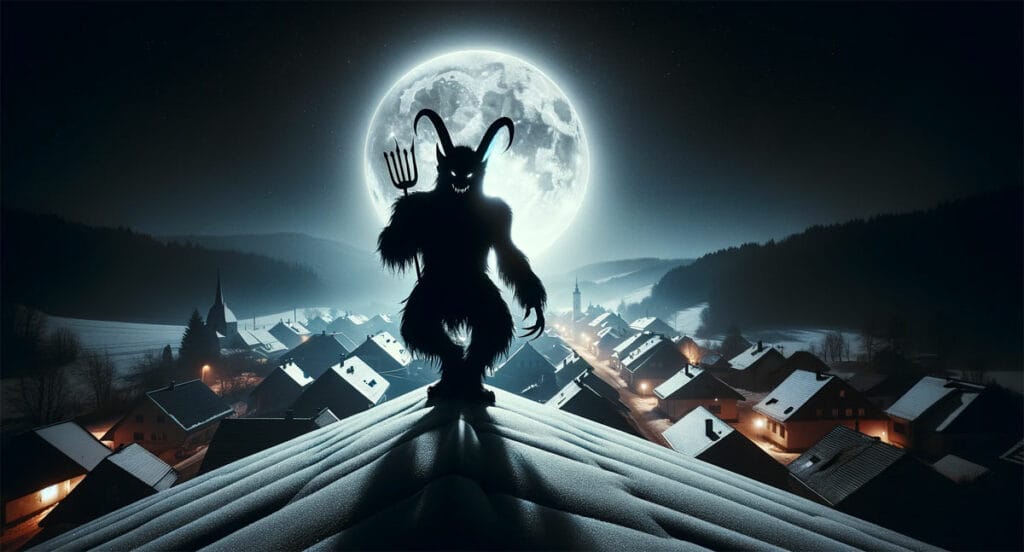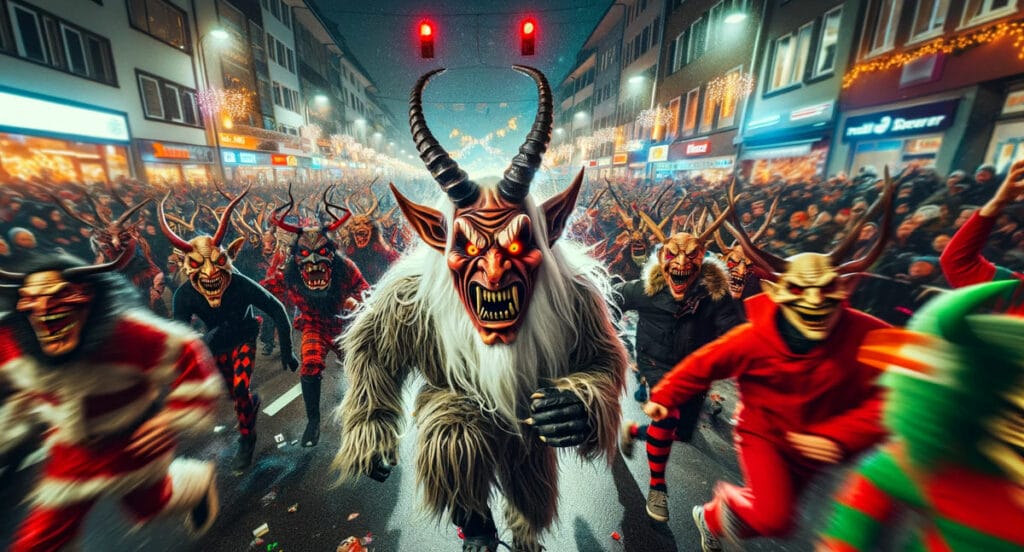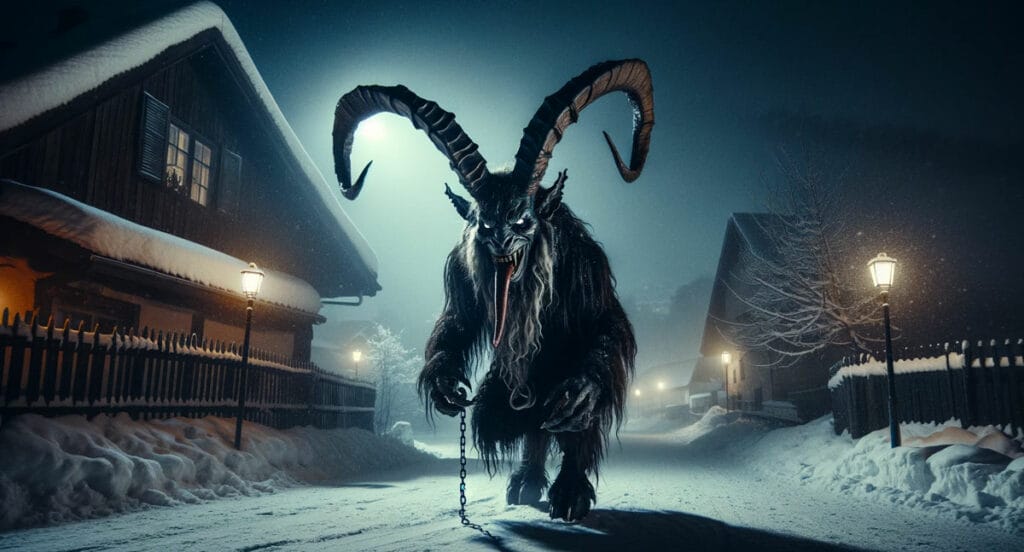Surly Krampus: The Shadowy Figure Lurking in Christmas Lore
As the shadow of the holiday season looms, you might catch whispers of a creature that embodies the chilling flip side of festive cheer. You’re familiar with Santa’s benevolence, but meet Krampus, the ominous enforcer of the naughty list. His haunting presence serves as a stark reminder that for every reward, there’s a consequence.

Look out for a figure with large goat-like horns and shaggy fur, accompanied by the eerie sound of chains clinking—a warning to naughty children. As you decorate for the holidays, keep in mind that surly Krampus is part of ancient myths and folklore, a haunting reminder to maintain good behavior amidst the festive cheer.
Dive into the legend that has captivated and cautioned generations, and understand why you’ll want to be on your best behavior as the year wanes.
Key Takeaways
- Krampus is a mythical creature from Alpine folklore and his origins can be traced back to pre-Christian pagan traditions.
- Krampus serves as Santa Claus’ counterpart, representing the balance of reward and retribution.
- Krampusnacht is a celebration on December 5th where people dress up as Krampus, visit homes alongside St. Nicholas, and administer symbolic punishment with birch branches.
- Krampus has gained popularity in popular culture, appearing in movies, TV shows, and various forms of media, and inspiring a range of products.
Origins of the Krampus Legend
The Krampus legend traces back to ancient Alpine traditions before it was linked to Christmas. This surly horned figure is a contrast to the festive season, originating from Alpine folklore. In the myths of Central Europe, Krampus isn’t just meant to scare; he represents the consequences for bad behavior, balancing out Saint Nicholas, who rewards the good.
As Saint Nicholas prepares his list, Krampus pays attention to those who’ve misbehaved. Krampusnacht, on December 5th, is when Krampus is believed to come out. Legend has it that he punishes bad children with birch branches or takes them away in his sack.
Krampus’s appearance, with twisted horns and a menacing face, serves as a reminder of the good and bad in human nature, reflecting ancient Central European stories. You are now part of this legend, a modern reflection of old traditions, a hint of ancient spirits in the winter air.
Krampus and Saint Nicholas
When exploring the eerie tales of Krampus, it’s important to understand his close connection with Saint Nicholas during the holiday season. Saint Nicholas gives gifts to good children, while Krampus is like a dark version of Santa, punishing the naughty ones. They represent a balance between rewards and consequences.
Krampusnacht, on December 5th, is when Krampus takes the spotlight. During this night, people dress up as Krampus and march through the streets in “krampus runs,” scaring and entertaining onlookers, while carrying birch branches, a sign of the discipline Krampus is known for.
The pair, Saint Nicholas and Krampus, teach a clear moral lesson: good behavior is met with gifts, and bad behavior attracts Krampus’s punishment. It’s intriguing to think about Saint Nicholas’s link to Krampus, which adds a darker tone to the holiday season, reminding us to behave well.
Traditions of Krampusnacht
The night before St. Nicholas Day, December 5th, brings a spooky tradition to life in the Alpine regions of Europe. Krampusnacht showcases the sinister side of Christmas folklore with striking authenticity.
During this night, parades fill the streets with people dressed as Krampus. They wear costumes complete with horns, dark fur, and terrifying masks. As they walk through the streets, their chains rattle and bells jingle, scaring those who watch. This eerie display is both alarming and enthralling, revealing a side of Christmas far from the usual joyous celebrations.

Digging into Krampusnacht traditions, you’ll find stories of Krampus accompanying St. Nicholas on home visits. St. Nicholas gives gifts to good children, while Krampus carries birch branches to warn the naughty ones.
Krampusnacht is a night that embodies the contrasting nature of the holiday season, blending cheerfulness with a hint of naughtiness. It’s a stark reminder for everyone to behave, lest Krampus comes knocking.
Exploring the Global Reach of the Krampus Legend
The Krampus legend comes from old Alpine folklore and has spread far beyond its original home, becoming a well-known figure in many cultures globally. This fascinating yet slightly spooky character is celebrated in various countries, each giving their own twist to the tradition.
Here’s a table that shows the countries where Krampus plays a major role in holiday folklore, illustrating how the legend has integrated into diverse cultural festivities.
| Country | Description |
|---|---|
| Austria | The heartland of Krampus tradition, Austria witnesses elaborate Krampusnacht celebrations, where Krampus is a central figure alongside Saint Nicholas. |
| Germany | Particularly in the southern regions like Bavaria, Krampus is celebrated with parades and runs, known as Krampuslauf. |
| Italy | In Northern Italy, especially in South Tyrol, Krampus forms a part of the Christmas festivities. |
| Slovenia | Known as Parkelj, Krampus is an integral part of the Christmas tradition in Slovenian Alpine areas. |
| Czech Republic and Slovakia | Accompanying Saint Nicholas, a Krampus-like figure is part of the Christmas customs. |
| Hungary | Krampus joins Mikulás (Saint Nicholas) during the festive season, continuing the tradition of the fearsome companion. |
| Croatia | Close to Slovenian and Austrian borders, Croatian Christmas traditions also embrace Krampus. |
| Bavaria and Tyrol | These regions are famous for their Krampus Run events, where locals dress up as Krampus and parade through the streets. |
In recent years, the Krampus legend has also found a foothold in North America, particularly in the United States and Canada, where Krampus-themed events are gaining popularity. This spread of the Krampus tradition underscores the fascinating ways in which cultural practices can traverse borders and find new expressions in different parts of the world.
Krampus in Popular Culture
Krampus has gone beyond Alpine traditions and made a name for himself in movies, TV shows, and other media, becoming a staple in modern entertainment. This horned Christmas foe has risen to prominence, particularly during the holiday season.

Take the 2015 horror-comedy ‘Krampus,’ where a family’s holiday gathering quickly turns into a battle for survival against the legendary creature. The film cleverly mixes frights with a satirical look at the stress of holiday family gatherings.
On TV, Krampus has popped up in hit shows like ‘Supernatural’ and ‘American Dad!’ where he’s portrayed with a unique spin—sometimes funny, other times quite dark—showing his versatility in pop culture. In the gaming world, Krampus adds a touch of mythical horror to games like ‘CarnEvil’ and ‘The Binding of Isaac.’
Krampus has also become a favorite for merchandisers, with products ranging from themed Christmas sweaters to action figures. He’s even featured in graphic novels and comics that explore his eerie backstory. Clearly, Krampus’s influence extends well beyond the Alpine mountains, firmly planting himself in the world of pop culture.
The Evolution of Krampus Imagery
You’ll notice that depictions of Krampus have transformed significantly from his folkloric roots to his modern pop culture representations.
Originally, Krampus was portrayed as a fearsome devil-like creature with horns, dark fur, and a lolling tongue. He carried chains, symbolizing the binding of the Devil by the Christian Church, and birch branches for swatting naughty children.
As centuries passed, Krampus’s image evolved. In early 20th-century postcards, you see a more mischievous than malicious entity, sometimes with a humorous twist, embodying a balance between fear and fun. He’s still horned and shaggy but less intimidating, often depicted capturing children in baskets or bags.
Today, Krampus’s image is a blend of old-world terror and contemporary horror aesthetics. He’s become a darker figure once again, partly due to a resurgence in appreciation for folklore and partly because of the modern appetite for the macabre. In movies, comics, and art, Krampus is often shown as a towering, sinister beast, a stark contrast to the jolly image of Santa Claus.
This evolution reflects a society that revels in the complex interplay between horror and holiday cheer, with Krampus standing as an icon of Christmas for the daring.




